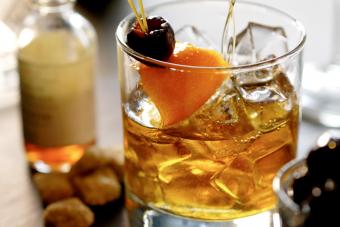
I love the smell of savory wine-braised short ribs or coq au vin wafting through my kitchen. The addition of wine to these foods adds deep, rich, savory flavors and heavenly aromas. And wine isn't the only alcohol you can cook with.
While booze makes food delicious, there's an art to it. Cook it wrong, and you'll wind up with harsh or bitter flavors. So whether you're making vodka sauce, using wine in a beef Burgundy, or flambéeing with rum for bananas foster (one of my personal favorites), we're here with some tips for cooking with alcohol so you can get every recipe just right every time.
How to Cook With Alcohol
How and when you add alcohol to recipes affects the flavor of your foods. You need some of the alcohol to cook off to prevent harsh flavors. But our tested-and-true expert methods will help you get it right for every recipe.
Pan Sauces
When creating a pan sauce, add alcohol to the hot pan after you've sautéed your aromatics (onions, celery, carrots, peppers, garlic) and before you add other liquid ingredients, a process called deglazing. After you've added the alcohol, scrape any browned bits from the bottom of the pan with a wooden spoon or spatula so you can incorporate more flavor into the food. Add other liquid ingredients 3 to 4 minutes after adding the booze.
Braises and Soups
In braises, simmered sauces, and soups, it's best to add alcohol after you've sautéed meats and aromatics before adding other liquid ingredients. This allows you to deglaze the pan and remove alcohol's harshest flavor components. Add the remaining liquid ingredients after about four minutes.
Gravy
In gravies, add alcohol after you've made the roux (stirred in flour and cooked it with fat). Add the booze and cook, stirring, for three minutes, and then add other liquids like stock.
Baking
Baking is a very specific chemical process, so follow baking recipes exactly, adding alcohol as outlined in your recipe.
Flambées
Be careful when you flambée. It's not the time to wear your favorite bell-sleeved top or fluttery dress or have your hair long, loose, and loaded with hairspray. While the alcohol, which burns with a blue flame, should burn out after just a few seconds, it's best to take some basic safety precautions.
- Always have a pot lid nearby in case you need to extinguish flames.
- Remove the pan from the heat source before you add the booze.
- Keep your hair tied back and secure any loose clothing.
- Tilt the pan away from you when you light the flame.
- Use alcohol that is between 80 and 100 proof. Higher-proof alcohols are dangerous to flambé.
To flambé, complete the following steps.
- Remove the pan from the heat source.
- Add the alcohol and allow it to warm gently for about 10 seconds. Do not stir. Alternatively, gently warm the alcohol to about 130 degrees before adding it to the pan.
- Tilt the pan away from you and light the alcohol with the burner flame (or using a taper lighter).
- Allow the flames to burn out. They'll go out on their own when the alcohol burns off.
Tips to Get the Best Flavor out of Alcohol When You Cook With It
These tips can help keep your food tasty when cooking with booze.
- Avoid alcohol labeled "cooking" such as "cooking wine." This has salt added, which can result in an overly salty dish.
- Never cook with an alcohol you wouldn't drink. If the booze has such inferior flavors you wouldn't enjoy drinking it alone, then it will add those flavors to your food, too.
- If you aren't much of a drinker, buy mini alcohol bottles instead of full bottles for cooking. You can buy small bottles of wine, liqueurs, and spirits for cooking and waste less.
- It's best to remove a hot pan from the heat source before adding alcohol to reduce risk of fire. You can return it to the flame as soon as you add the booze.
- Never pour alcohol into a hot dish from the bottle. Instead, measure it and add from a measuring cup. That way, if the alcohol does accidentally ignite, you won't have a larger fire on your hands.
Alcohol Burnoff

Many people assume that heating alcohol for a few moments burns it all off. It doesn't. While cooking alcohol over high heat for a few moments does minimize the harshness, so you only taste its mellower flavors in the food, it takes quite a length of sustained cooking for alcohol to completely burn off.
Ethyl alcohol, the kind found in booze, evaporates at about 173°F. While it begins to evaporate at this temperature, it does so quite slowly.
In 2007, the USDA performed an analysis of alcohol and nutrients lost through cooking and determined the rate at which alcohol burns off during various cooking methods.
- When you flame alcohol until the flames go out (flambé), it burns off approximately 25%.
- When you add alcohol to a boiling liquid (usually a sauce or braise) and remove it from the heat, the residual temperature burns off about 15% of the alcohol quickly. It may take several hours of sustained heat to remove all traces.
- If you add alcohol to a simmering sauce/braise or stir it into a batter and bake it, about 60% will burn off after 15 minutes. For each additional 30 minutes, about 5 to 10% burns off. Even after 2.5 hours of cooking, about 5% of the alcohol remains.
Don't worry — you don't need to burn it all off. Follow the instructions above, and you'll get great flavor with a little booze remaining in the dish.
Better Cooking With Booze
Cooking with alcohol can add depth to foods and balance flavor profiles. By using proper alcohol cooking techniques, your food will always be tasty.







